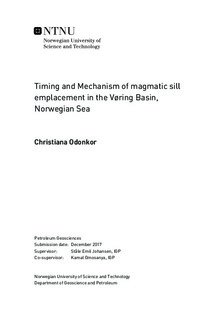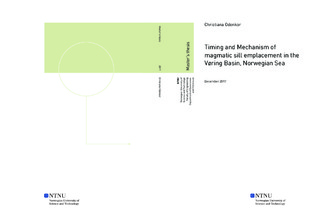| dc.description.abstract | The Cretaceous sediments of the Vøring Basin, Norwegian Sea, are locally intruded by sever-al igneous sills, which are mainly Doleritic. 12 magmatic sills were interpreted in the on high resolution 3D seismic data, together with petrophysical data form wells located in the area. Sills were inrterpreted mainly in the intermediate and deep parts of the area and they were characterized based on their geometries.
Seismic-high amplitude anomalies were necessary for interpreting and characterizing the magmatic sills in the study area. Magmatic sills also show saucer-shaped geometries, trans-gression across strata and abrupts terminations. Magmatic sills showed complex geometries such as saucer-shape, eye-shape, layer-parallel, transgressive and fault-plane. The saucer-shaped sills dominate the intermediate levels whereas the layer-parallel dominate the deeper parts of the Vøring Basin.
Brittle fracture and ductile mechanisms were the techniques employed in attempting to under-stand controls on intrusions in the study area. Brittle deformation such as steps and hydro-thermal vents are evident in the area, likewise, ductile deformation such as folding. Magmatic sills have preferentially exploited weak zones such as faults planes. Sills growth was through feeding of sills from a point source to form mainly radially symmetrical morphologies. Sill have exploited faults zones to form transgressive sills in the study area.
Hydrothermal vents and intrusion-related forced folds are found associated with the inter-preted igneous sills and interpretation of their stratigraphic context constrains the timing of intrusion to the Late Paleocene to Earliest Eocene. The intrusive event is coincident in time with the final rifting in the Vøring basin, culminated with complete lithospheric separation accompanied by massive igneous activity occurred at the Paleocene Eocene transition, where, intrusive activity was intensive during the Paleocene age.
Circulation of hydrothermal fluids following intrusion is likely to have affected reservoir units and have influenced fluid migration pathways within the basin. Hydrothermal vents and gas-charged sediments are proof of vertically focused and active fluid-flow in the study area. The forceful intrusion of igneous sills has produced forced folds forming potential four-way-dip traps in the overlying section and potential stratigraphic traps in the form of pinch-out of post-intrusion deep-water clastics against the folds. | |

